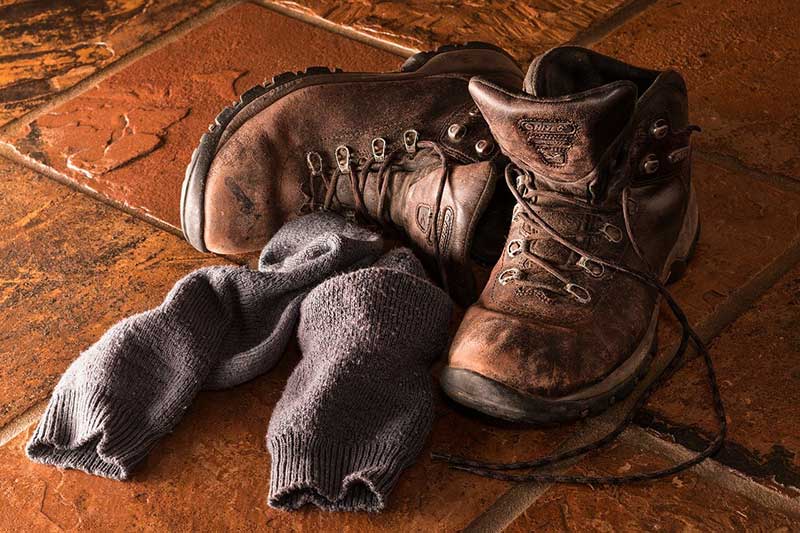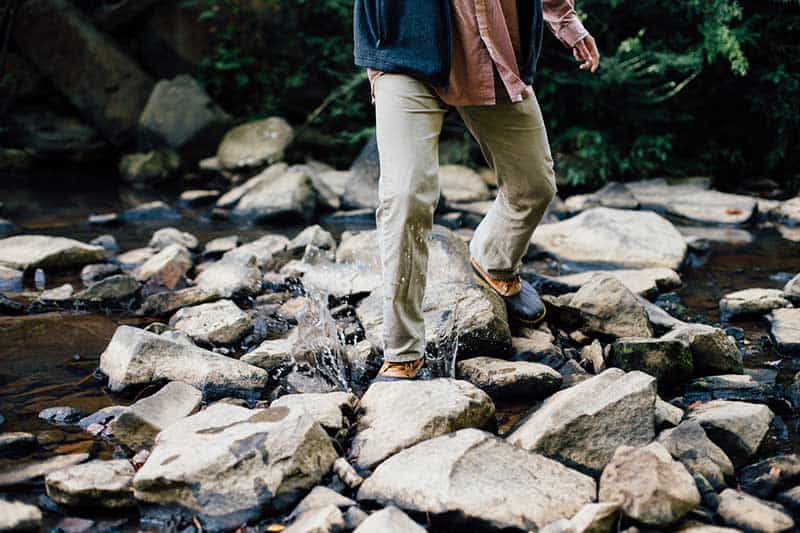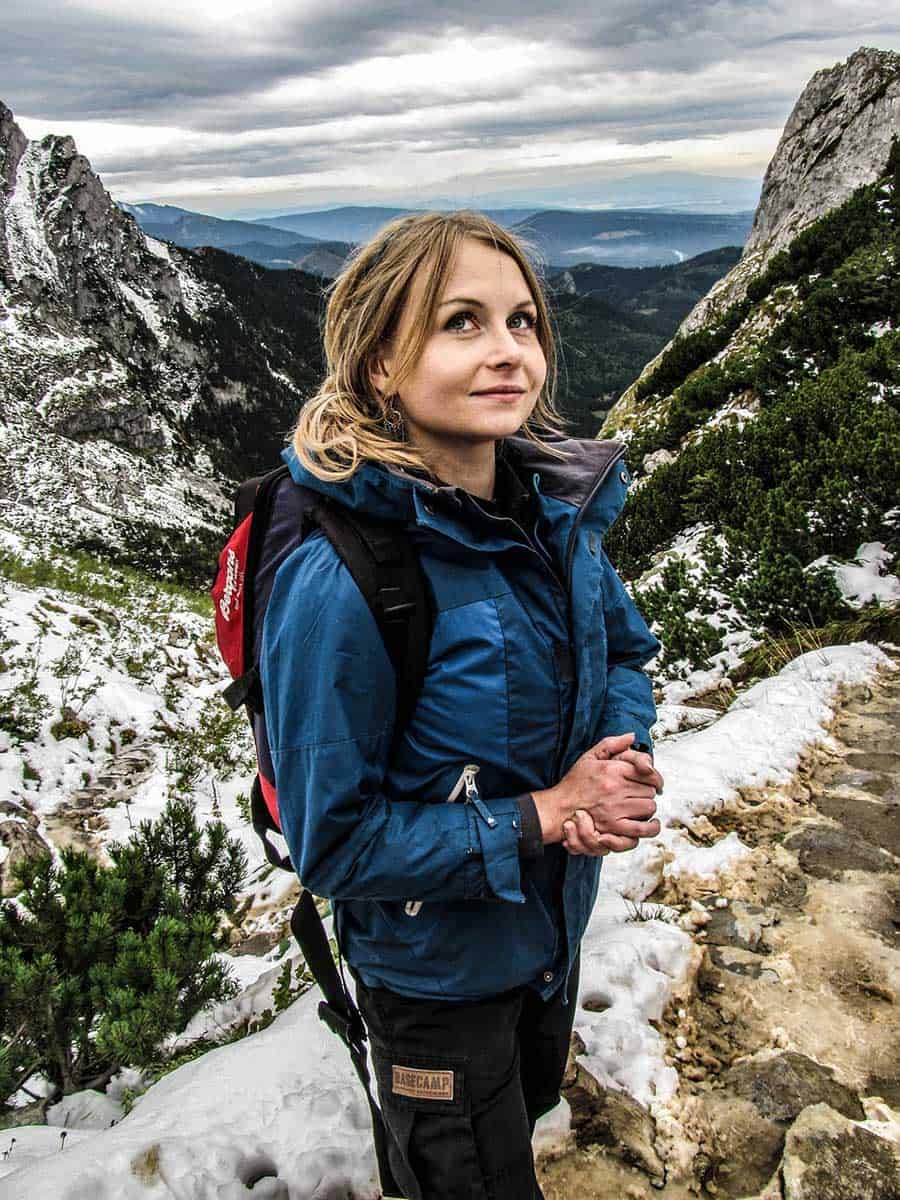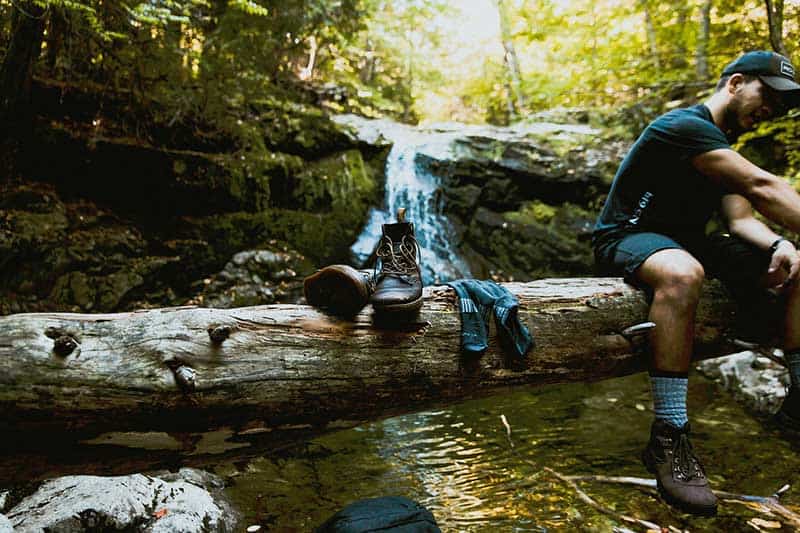Hiking in cold weather has a lot of advantages. I love spotting new things on familiar trails, now that the leaves are gone. It’s nice to leave the insect repellent behind, and it’s great to keep up the fitness routine without a layer of sweat. Honestly? It’s my favorite time of the year to hike. There’s one weak spot in the whole winter hiking activity scheme, though, and it’s one that will bring strong men and women to their knees. It will make whiners out of winners. And that weak spot is cold feet. You need to know how to keep your feet warm while hiking in cold weather.
That’s what we’ll be discussing in this article.
How to keep your feet warm while hiking
I’m not talking about the kind of cold feet that you get when you are looking at a really steep trailhead and can only think about your nice warm coffee waiting for you back in the parking lot. No, we’re talking literal cold feet, the kind that you get when you decide to throw on your white cotton crew socks and hiking shoes, the cold feet that creep in toe by toe. The frozen bricks that make every step an internal monologue about all your bad life choices and how they feel just like your feet right now.
Do not get stuck questioning your whole life while you trudge with frozen feet back to your car. Buy the right socks. They will change everything. We will help you find the right ones, and help you look for some good winter hiking boots, should you be lacking in that area.
What’s the best fabric for hiking socks?
At the most basic level, this is where you need to start your search. The fiber that your socks are made from is one of the most important factors in finding the right socks for winter activities.
Keep this in mind – even in the middle of the winter, your feet are going to sweat. They’re wrapped up in hiking boots, doing all the work, and this creates a problem. Where does it – you know – go?
In the best case scenario, it’s actually getting wicked – as in pulled away from, not evil – away from your hard-working feet. Otherwise, you are left with moist, cold, feet, wrapped up in cold, moist socks. You’ll quickly find out that good hiking socks today all use mostly merino wool in their construction, with a handful using a mixture of synthetic fibers or cotton.
Synthetic fibers have been rolled out in socks for some time now. You’ll see blends like CoolMax, which is a polyester, mixed with nylon, acrylic, and Lycra.
These offer a more economical sock, and often a two-layered construction that helps with blisters and slipping. Much like its synthetic cousin, fleece, the fibers used in these socks are lightweight and easy to care for.
If you have an allergy to wool, these are the best alternative. They are soft, wick moisture well, and feel more like a traditional athletic sock.
However, they do come with some drawbacks. First of all is longevity. They simply don’t wear as well as wool socks, for example. You’ll likely begin to see wear spots after several hikes in synthetic fibers, whereas a wool version will still look good.
Secondly, synthetic fibers retain odor much more than natural fibers. You may have noticed this before with other workout gear. Someday, they’ll figure it out, but it’s still an issue.
Why cotton socks aren’t great for hiking
You’ll find that the best socks will have a good portion of wool in their blend. What you will not find? Cotton. Cotton socks are not your winter hiking friend, and you don’t want to find this out the hard way. Other than the lack of wicking ability, cotton is terrific at soaking up water, and will do just that if you get your feet wet. And, it will hold onto it, not dry out, and lose all its insulating capacity.
When it comes to wet socks and moisture, cotton socks are like bath towels, and wool socks are chamois cloths. Your feet will prefer the latter.
Merino wool socks – why they’re great for hiking
Merino is not the coarser, thicker wool you may be thinking of. Made from a finer yarn, it makes softer, denser socks that still work incredibly well to keep feet warm while still wicking moisture. They’ll also be thinner – which makes for better-fitting boots. Merino wool also makes socks very long-lasting – it’s not uncommon to have a good pair go on for years without holes or problems.
Wool socks are also supreme for blister prevention. The fact that they are soft, keep moisture away from your feet, and provide more cushioning will save you a lot in adhesive bandages.
There are a lot of designs in socks, but I love the Darn Tough brand for overall quality. They are seamless, have a full foot cushion, and their fit is awesome. These types of socks don’t slip around in your boots, they don’t rub, and they are a mid-calf height, which keeps you feeling even warmer. They also come in a huge range of sizes.
They’re made in the USA, and have a lifetime guarantee. That’s a LOT of hikes, so pick out colors you like. You’ll be wearing them lots of places. The last pair of Darn Tough socks I bought were these from Amazon and I have worn them on many hikes and love them.
Here are a couple more options for Merino Wool Hiking Socks:
Hiking socks care and maintenance
Once you’ve gotten your hiking socks, you’ll want to take care of them properly. Here’s something that will win you over – wool is naturally antimicrobial. The science behind smelly socks is full of bacteria and probably not something you want to get too far into when you’re just looking for warm feet. I’ll leave it with this – wool socks do not get as smelly as other socks.
If you are looking for socks that you can wear for a long time, in really cold, brutal conditions, and then keep on in your sleeping bag – wool is the way to go. You’ll still want to wash them, though. How often? When you feel like they are actually dirty enough, not every time you wear them.
Sock manufacturers realize that their customers do not want to spend time hand-washing their wool socks, or doing anything fancy with special detergents. You’ll be glad to know that your socks will do just fine in the washer, using cold water. Don’t use fabric softener. If you can, let them hang dry – this will help with their overall longevity. They will retain their shape just fine, and be dry sooner than you think. This is because today’s socks have some synthetic fibers in them that help them keep their heels and toes in the right place, and dry even faster.
Choose hiking socks wisely
When you’re selecting socks, remember you are fitting them to your actual foot size, not your boot size. If you’ve been buying your boots in a larger size to accommodate for heavier socks, make sure you’re using your foot size when you’re looking at the size charts – especially if you’re right on the edge of sizing up. You don’t want any extra fabric slipping around in your boot – it defeats the whole purpose of comfortable, blister-free hiking.
You want a snug, but not tight fit. The heel cap is particularly important. Check to see that it lines up with your own heel. Look for a pair that doesn’t sag or feel loose around your toes, or bunches up around your ankle or arch.
When it comes to the sock height, you’ll find that hiking socks are sold in everything from knee high to no-show. Since you’re looking for a good winter sock, you’ll want to go with the crew height, which will cover up your ankles and not get lost in your shoe or leave your lower legs cold.
How should I dress for a Winter hike?
Now that we’ve solved the issue of frozen feet, let’s move on to keeping the rest of you warm and comfortable during your hike.
Layers are your friend for cold weather hiking. Just like you’ve learned about your hiking socks, you will want a base layer that can handle sweat without clinging to you like a cold, wet, rag.
Sadly, this is not the time to break out your cotton t-shirts – you probably saw that one coming. Again, the best cold-weather layers are either merino wool or synthetics.
You’ll want something that fits close, because this is the layer that you will be intending to keep on. There are a couple of schools of thought on the design. The first type of base layer is cut like a traditional crew-neck shirt, with a round neckline. The second has a zip-neck that usually extends higher on the neck.
The first style is off your neck, and allows you to have more ventilation. If you hate a lot of extra fabric around your neck, and might be peeling down tooth’s layer during your hike, this is a better choice.
If you tend to adjust for the temperature on the trail, you will want to select a zip neck. Not only can you keep your neck warmer, it will allow you to also get a bit more ventilation, if you get too warm. It’s sort of like your car’s thermostat – if you just set it and go, go with option A. If you’re always trying to find the perfect temperature, go with the zip neck.
Synthetic material and merino wool is best for hiking (warm and cold weather)
As for your other layers, ditch the cotton, and look for merino wool or synthetics. Turns out that the same things you’re looking for in a good pair of socks work well on the rest of your body. It’s better to have multiple layers that you can adjust during your hike. No jeans – look for something sturdy, but not cotton. You don’t want a hole in your pants on a winter day, and you don’t want wet pant legs clinging to you if you get wet.
Outer layers should reflect the weather – be prepared if it rains, and try to use a waterproof/breathable outer jacket. It helps with keeping you dry and warm – not steamy and warm. I personally always pack along a knit cap, and a pair of gloves or (my favorite) mittens. Unless you’re going to be doing a lot of texting or doing a lot of fine finger movement on the trail, mittens will keep your hands warmer than gloves.
Don’t forget the boots
Lastly, keep your feet at their happiest by using good hiking boots. The best socks in the world will not help if you have inappropriate footwear. However, make sure to wear your awesome new socks when you try on hiking boots.
Winter hiking boots are likely to handle a bit more, and you’ll want to look for these additions.
Waterproofing
While these might be too much for summer, you’ll welcome the dry warmth in the cold weather. Go for a boot that is legitimately waterproof, and you’ll never worry about snow or sludge ruining your hike.
Insulation
Just like snow boots, you’ll learn to appreciate the extra insulation that is offered in some winter hiking boot styles. It adds warmth without weight.
Gripping Soles
Winter hiking boots often come with a grippier, more rugged sole that can handle the slippery winter conditions. They also will have a reinforced toe section that can withstand plowing through snow and wet.
Here are some great choices for hiking shoes that perform well on slippery surfaces.
You also don’t have to restrict yourself to an extremely heavy boot – a style like the Keen Revel III is a great choice for winter hiking. It comes in both men’s and women’s styles. The nubuck leather is waterproof, and it comes with both a breathable, waterproof membrane and 200-gram insulation. It won’t feel bulky or awkward – but it will keep your feet dry and warm, with minimal break-in time required.
Conclusion
Keeping your feet warm and dry is one of the most important aspects of cold weather hiking – it’s sometimes all you can think about, if you don’t choose the right socks. It’s all in the materials – with the right blend of natural and synthetic fibers, you can now find warm socks that don’t feel thick, but are still cushioned and capable of preventing blisters.
The same blends of fibers also make for successful cold weather hiking clothing. Take the same concepts and apply them to your base layers and other pieces for winter hiking trips that will leave you feeling exhilarated, not exasperated.



